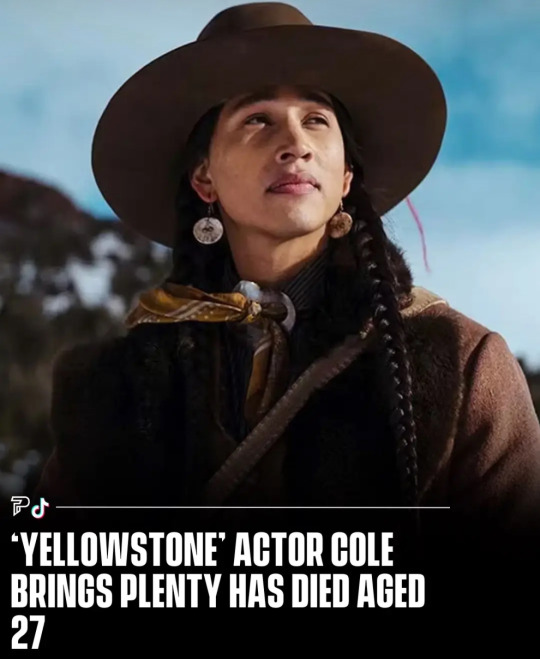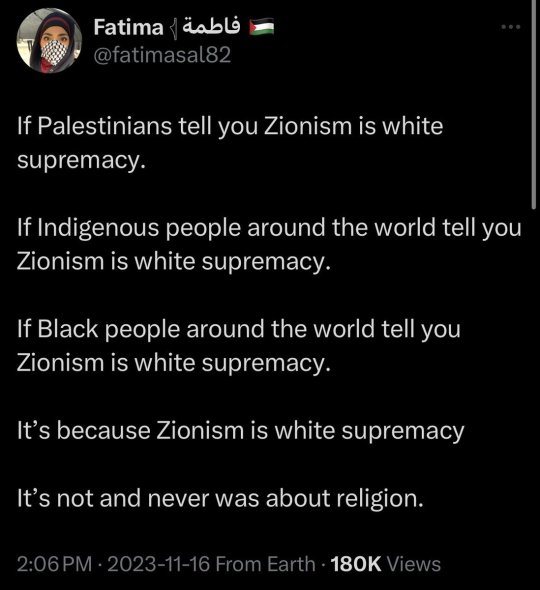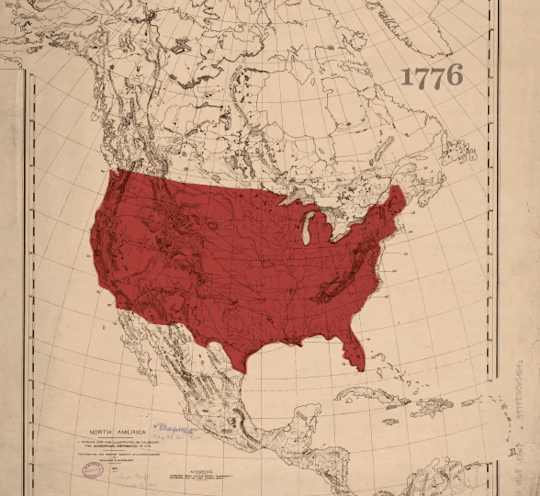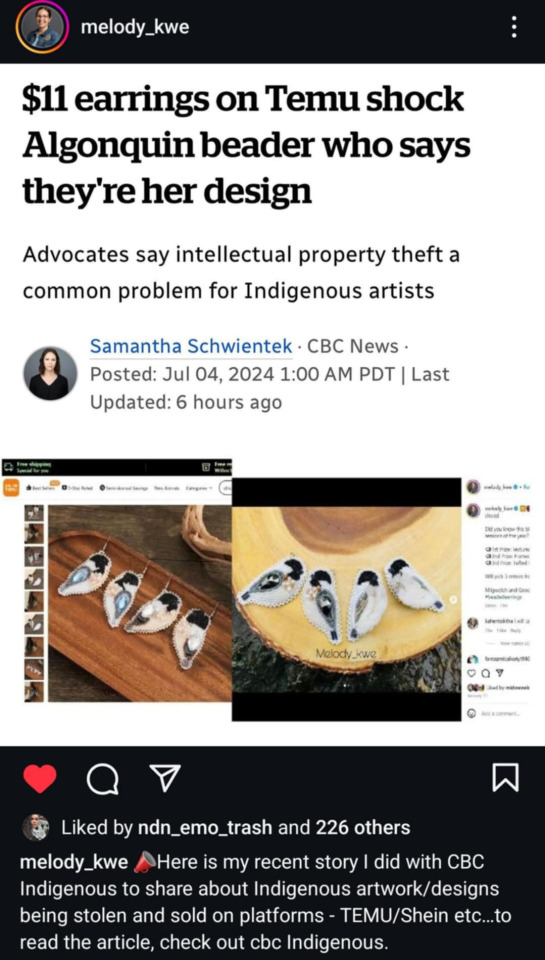#anti-indigenous
Explore tagged Tumblr posts
Link
#american indian movement#cointelpro#fbi#activism#counterinsurgency#anti-communism#anti-indigenous#indigenous#indigenous people
106 notes
·
View notes
Text
"Ben-Tor posted the clip on October 19 to the Instagram account she runs with fellow Israeli artist and collaborator Miki Carmi. In the video, the artist delivers a sarcastic monologue while wearing a mask that many on social criticized as (is) a “racist caricature” of Arabs or Palestinians. Some critics used the term (this racist performance trope is called) “Arabface” in describing the artist’s performance... Past works by (Tamy) Ben-Tor show her caricaturing Arab people; in what appears to be the artist’s YouTube channel chronicling her performances, one video uploaded in 2012 shows Ben-Tor in the guise of a character she calls “Dr. Hammam, Middle East expert and civil rights activist” who makes anti-Jewish remarks. In another piece, from 2004, Ben-Tor appears to play the role of Hitler while wearing a Palestinian keffiyeh. In a 2005 video titled “Girls Beware,” Ben-Tor again dresses as an Arab man, this time delivering catcalls, then makes anti-Arab comments while playing the role of a sex worker."
#israeli apartheid#White Supremacy#Zionism#contemporary art#tamy ben-tor#israeli art#racist caricature#propoganda#white people#anti-indigenous#Arabface#us politics#qsmp#mass effect#one piece#taylor swift#the eras tour#loki#wwdits#mcr#dnd#the marvels#stranger things#noah schnapp
4 notes
·
View notes
Text
Quakers did this too, running dozens of Boarding schools in the Americas. My great-great-great-great grandfather was among the first generation of indigenous Americans to be taken from his parents to be civilised by a “nice, generous, Quaker couple.” The boarding schools would follow about 20 years later.
For a more thorough (and heart-breaking) read, see the link I have below. It contains stories from both the Quakers involved AS WELL AS the children who were ripped from their homes. It’s important to note that the people involved really thought they were doing the right thing, that they thought they were on the right side of history, because they ALWAYS do, no matter who it is they’re taking from their own people. They *utterly fail* to understand that the children they take have their own rich culture, their own beliefs, and no amount of breaking them and turning them into “good little xtians” can erase that heritage.
Ugh
Anyway:
Love seeing something from TikTok and going “girlie that is literally what led to the downfall of the Papal States”
93K notes
·
View notes
Text
youtube
#disney critical#disney racism#anti-Indigenous#video#meta#cc#settler colonialism#I was a child when this came out but she's used remarkably similarly to la Malinche in terms of propaganda#also the white fuckers in my class trying to educate me about Indigenous issues was a mindfuck
0 notes
Text
this headline is so fucking horrible why is it whenever indigenous people are murdered everyone avoids saying they were murdered
edit: i was really angry and sad when typing this out so i worded this badly. i know the journalist can’t say murdered when the police haven’t called it what which isn’t surprising considering how often police fail the indigenous community. however this headline should have at least said “found dead” or something like that

39K notes
·
View notes
Text
October 21, 2024 - Lidia Thorpe, an Aboriginal member of Australia's parliament told King Charles some truths as he was giving a speech in Canberra. [video]
#canberra#australia#aboriginal#lidia thorpe#anti-colonialism#indigenous#land back#indigenous rights#anti-monarchism#king charles#king charles iii#anti-monarchy#2024#video
6K notes
·
View notes
Text
#the use of the word “tribal” in the article is#anti-Indigenous#contrary to the article's presumed intentions
0 notes
Text

#anti zionisim#free palestine#rafah#twitter#democrats#republicans#gop#Woc#poc#blm#middle east#indigenous
4K notes
·
View notes
Text

This is the kind of free thinking Fascists want to crush.
#history#native american#indigenous#antiauthoritarian#antinazi#anti capitalism#earth#america#australia#australian#amerika#americans#class war#classwar#ausgov#politas#auspol#tasgov#taspol#neoliberal capitalism#fuck neoliberals#anthony albanese#albanese government#antifascist#antifaschistische aktion#anti imperialism#anticapitalista#anti capitalist love notes#eat the rich#anarchy
9K notes
·
View notes
Text
"It's not your responsibility"

0 notes
Text
Private Armies of Mindanao
From Filipino Free Thiners Private Armies of Mindanao Faraj Pangeran April 2, 2010 The Rise of Private Armies
Ever since the brutal slaughter in Maguindanao, it raised again the issue of private armies. Private armies exist everywhere in the Philippines and was an issue as far back as the early years of the American colonial regime in the Philippines. After independence was re-established in 1946, private armies were seen as essential to safeguarding the republic from the Huks. Since that time, private armies were seen more of a blessing to Malacanang Palace with the exception of Ramon Magsaysay who saw private armies not only as a lawless element but a threat to military readiness. According to the Philippine National Police, there are over 170 private armies in the Philippines and about 68 are found in the Autonomous Region of Muslim Mindanao (ARMM).
Land Struggles
The genesis of private armies in Mindanao can be traced to the discrimination experienced in the land system. Since time immemorial, both Lumads and Moros had a communal land system which meant that essentially as long as one took care of a piece of land, it was yours. When there was a dispute, a datu, chief, or sultan settled it for you and created a deed or edict.
With the establishment of American rule in Mindanao, a new land tenure system was imposed. This included “nationalizing” (really confiscating) ancestral communal lands of the Lumads and Moros into “public lands” under the Public Land Law of 1903. Lumads and Moros now had to register their land claims in Spanish or in English to the American authorities either in Zamboanga or in Manila and non-Christians were allowed only to claim up to 10 hectares while Christians could claim up to 16. It also voided any deeds or land claims made by sultans, chiefs, and datus. Furthermore, all Moros, Lumads, Igorots, and Aetas came under the supervision of the Bureau of Non-Christian Tribes of the Department of the Interior under the Governor-General. This meant in certain circumstances, a Moro or Lumad needed permission to even apply for a land title from the Bureau of Non-Christian Tribes. With the Public Land Act No. 2874, enacted in November 1919, this was increased to 24 hectares. At the same time, Moros and non-Christians were only allowed to claim up to 8 hectares. The amended public land law of 1936 reduced the homestead size back to 16 hectares, and cut the land claims for Moros and non-Christians to four hectares.
What this essentially did was not only to strip away the ancestral domains of Moros, Lumads, and every other indigenous group in the country, but made religion even a basis to gaining a land title. It also became a land bonanza for American corporations (i.e., Dole, Goodyear, etc.) and Filipino landed families including the Cojuancos, the Arroyos, and many others.
Beginning in 1912, landless peasants from the Visayas and Luzon were shipped to Mindanao and allowed easy access to claim land while Lumads and Moros were forcibly put into re-settlement programs on non-agricultural lands and monitored by the Philippine Constabulary. Christians on the other hand were encouraged to settle in the more productive lands especially along the coasts and corporations were given tax breaks and other measures to develop in Mindanao. This in turn also attracted a number of landed families particularly from Cebu and Manila who saw the opportunities, in particular, logging and mining.
Since technically a Christian person could only claim a certain amount of land, what some Filipino politicians and landlords in the Visayas and Mindanao did was to have their workers claim the land that they wanted, have their connections in Manila process the claim, and then the worker would “sell” that claim to them. Sometimes the workers were not even aware that they had even processed a claim. In this way, some families were able to establish huge estates and plantations in Mindanao without being in violation of the Public Land Laws.
This was compounded with the fact that Moros and other “non-Christians” could not vote, which is one of the reasons why there were no elected Moro, Lumad, Aeta or Igorot politicians during the Commonwealth. The non-Christians were supposedly represented through the Bureau of Non-Christian Tribes which were always staffed by Roman Catholics and never headed by a non-Christian.
During the resettlement programs under Magsaysay, Garcia, and Macapagal settlers were given land for free or simply had to pay a processing fee. These factors are actually the root of the conflict in Mindanao.
In the 1950s, friction began to occur not with just the indigenous populations of Mindanao and the new settlers but between competing politicians. Malacanang began to see the potential of Mindanao in giving that extra–often controversial–votes during elections; private armies had enjoyed support from whomever was president who naturally also came from a political dynasty. Thus, private armies in Mindanao had a two fold purpose: to maintain the political and economic power of political dynasties; and to legitimize the land claims of Christian settlers. In turn, this also would ensure that Mindanao would be part of the Philippine nation-state–something that many Moros still contest–and eventually be “Christianized”. In addition, there were new problems arising from the rise of Communism which gave the Armed Forces of the Philippines an excuse to supply private armies as a counter-insurgency measure.
Generally speaking, warlordism is most pronounced in Sulu, North Cotabato, Davao provinces, Lanao del Sur, South Cotabato, Surigao, Zamboanga, South Cotabato, Sarangani, and Sultan Kudarat–all areas where competition for agricultural land and natural resources is very high. Except for Sulu, North Cotabato, Lanao del Sur, and Sultan Kudarat, these private armies have been recognized at one time or another as a CVO or CAFGUs and are all employed by mining companies, plantations, and/or political dynasties.
Some of the more well known private armies in Mindanao include the Kuratong Baleleng of Ozamis City Mayor Ronaldo O. Parojinog. The Kuratong Baleleng was also instrumental in both Aquino and Estrada’s all out war in Minandao. In North Cotabato vice Governor Emmanuel Piñol maintains another private army. His private army includes its own factory in Mlang and produces mostly M-79 grenade launchers and improvised M-14 armalite rifles. North Cotabato Mayor Roger Taliño has several groups registered as Civilian Volunteers Organization (CVOs) and/or Civilian Armed Forces Geographical Units (CAFGUs), which means it received official backing and were given supplies by Armed Forces of the Philippines or directly by the Department of National Defense.
Not to be outdone, Muslim politicians–particularly in areas where land is contentious–began to arm themselves. “The Barracuda”, the private army of the late Lanao del Norte Governor Ali Dimaporo, is one such example. Dimaporo’s army was reputed to have more firearms than three army brigades and would make Ampatuan’s army look like a boy scout troop. Again, it should be remembered that many of these private armies–whether Muslim or Christian–were encouraged and supplied by our own government and therefore our own taxpayers’ money helped to pay for these armies.
Vigilantes and Liberation Fronts
A by-product of these private armies and the land situation led to the formation of the various Moro liberation fronts as well as the introduction of the New People’s Army (NPA) and vigilante groups in Mindanao. From a Moro perspective, the loss of land was not just seen as an alienation from one’s ancestral ties but as a deep humiliation. The Sultanates of Sulu, Maguindanao, and Lanao were symbols of resistance to foreign rule. But these sultanates were basically gutted by the Public Land Laws and everything else Moro were belittled by the Commonwealth and later the Republic of the Philippines. This was exasperated by the settler programs in the 1950s and 1960s where over a million people from especially the Visayas region displaced the indigenous populations and became the new majority on lands that were part of the Sultanate. Then to further highlight the position of Moros in the country, the Jabidah Massacre occurred in 1968 where 28 Moro recruits were executed by the Armed Forces of the Philippines (AFP) after the AFP decided to abandon its plan to invade Sabah and destablize Malaysia.
The MNLF
In light of all of this, the Moro National Liberation Front (MNLF) was formed in the 1970s and began waging a protracted war for independence. The chairperson of the MNLF, Dr. Nur Misuari, was a former professor at the University of the Philippines-Diliman and had been a member of the Kabataan MakaBayan (KMB) of Jose Sison. The KMB members later formed the nucleus of the leadership of the Communist Party of the Philippines.
Since the beginning of the armed struggle, the MNLF made it clear that their main issues in Mindanao were not religious in nature but were for self-determination and for the social and political inequalities that existed not just in Philippine society but within the BangsaMoro themselves. In the late 1970s as the MNLF began to spread through the Moro majority areas of Mindanao, the Communist Party of the Philippines at the same time began operations in non-Muslim areas in Mindanao.
This in turn led further government support of CAFGUs and escalated the violence, leading to the creation of right wing Christian vigilante groups whose goal was to wipe out both the Muslims and the Communists. These included the Alsa Masa, NAKASAKA, Causa Manifesto, Tadtad, and the Davao Death Squads. The Tadtad group was infamous for its practice of ritual cannibalism and keeping the ears of their victims as souvenirs.
Despite all of this, these groups got official approval not only from the government but also from the Roman Catholic Church who refused to condemn the killings or the death squads. The Auxiliary Bishop of Cebu, Msgr. Manuel Salvador, for example, said in 1986 that ”We really cannot blame these civilians who decide to arm themselves.” Certain other groups were also heavily supported by other Christian churches such as Rev. Sun Myung Moon’s Unification Church, and by anti-communist groups in the US. With the rise of right wing Christian groups, this lead also to the formation of fundamentalist Islamic groups such as the Abu Sayyaf.
One of the Legacies of President Aquino
One of the great ironies of all is that most of these right wing groups–both Christian and Muslim–did not form during the martial law, but during the administration of President Aquino. In 1987, President Aquino praised such groups as a ”concrete manifestation of people power”. The roots of the armed struggle in Mindanao was not originally rooted in religion but in the social inequalities and discrimination until the rise of groups such as the Alsa Masa which occurred during Aquino’s presidency. Likewise, it should be remembered that many of the Muslim politicians like the Ampatuans received their start in politics by being appointed to office by President Aquino and these same people continued to build their private armies with the support of Ramos, Estrada, and Arroyo. Many of these vigilante groups and right wing paramilitary forces still exist today.
The MILF
In 1986, the MNLF and the Aquino administration entered into talks and the MNLF gave up its goal of independence. This gave birth to the Moro Islamic Liberation Front, the Moro National Liberation Front-Reformist, and other smaller groups. The Moro Islamic Liberation Front, in particular, is not secular. It not only believes in BangsaMoro self-determination but also in “Making the Word of Allah Supreme”.
It is also an open secret that the MILF is supported by elements within the Prime Minister’s Office of Malaysia and the Ministry of Foreign Affairs of Malaysia in their special “Moro Desk”. The Malaysian government has a vested interest in the MILF not only because of the Philippine government’s past support of Indonesia during the Konfrontasi but also because the MILF is predominately Maranaw. The MNLF on the other hand traditionally has its mass support from the Tausugs. The Tausugs have claims to Sabah and have been close to Brunei and Indonesia–Malaysia’s rivals. The Maranaw do not have any territorial claims to Malaysia and traditionally have been close to Malaysian royalty. So the struggle between the MNLF and the MILF is not only an ideological struggle (i.e. secular versus Islamic, integration into the Philippine nation-state versus independence, etc.) but also in a way a proxy war between Malaysia and the Philippines over Sabah.
Dismantling the Private Armies
With the outburst of public anger about the massacre in Maguindanao, the current president, Gloria Macapagal-Arroyo, vowed to dismantle private armies. Of course the same sentiments had been said since the time of the Commonwealth. However, the roots of the conflict in Mindanao, the rise of private armies, and the formation of right wing groups are all tied together because it is all based on the social inequalities existing in the entire country (especially regarding land), on the weakness of the judicial system, and to a degree prevailing cultural and religious arrogance. Until there is genuine land reform, genuine electoral reform, a fairer distribution of resources for Mindanao, mutual cultural acceptance, and an efficient, fair and independent judiciary where no one is above the law–the country will always have Communist guerrilla fighters, right wing factions, private armies, and other CAFGUs types.
Originally posted here: https://filipinofreethinkers.org/2010/04/02/private-armies-of-mindanao/
#mindanao#philippines#the philippines#cafgu#paramilitary#anti-communism#counterinsurgency#Gloria Macapagal-Arroyo#politics#aquino#moro#lumad#indigenous people#anti-indigenous
2 notes
·
View notes
Text
#indigenous#native american#ndn#barbie#barbie movie#barbie 2023#tbh that line threw me#made me squirm#and i also didnt like the mnt rushmore cameos#racism#native#cinema#anti indigenous racism
7K notes
·
View notes
Text


You are not my King! This is not your land! You committed genocide against out people. Senator Lidia Thorpe to Charles
#british royals#royals#british royal family#king charles#queen camilla#camilla parker bowles#brf#uk royal family#royal tour#australian republic#not my king#anti monarchy#indigenous#lidia thorpe
748 notes
·
View notes
Text
YOUR FAVE IS ANTI NATIVE: Temu and Shein

Don't support businesses that steal Indigenous artwork and then mass produce it for pennies. Support Indigenous artists and shops.
#your fave is anti native#temu#shein#cultural appropriation#art theft#cultural theft#this is not native#buy native#buy indigenous
1K notes
·
View notes
Text

January 25, 2024 - A day before the celebration of "Australia day" the statue of Captain Cook in St. Kilda, Australia, was sawn off at the ankles, with the words "The Colony Will Fall" painted on the statue's plinth.
#invasion day#anti-colonialism#st kilda#australia#australia day#statue#vandalism#indigenous#indigenous resistance#aboriginal#2024#monument#graffiti#spray paint#direct action#captain cook
12K notes
·
View notes
Text
after watching a police interview with nex benedict it is !!my opinion!! that they were dismissive and negligent, as well as the school.
this petition calls for an independent investigation into their death, especially since the police have take the liberties to claim that it was not the result of head trauma(interpretation, not fact.). and i think you all should sign it 👍 they’re only 50ish votes from their goal but we should still go over that.
#our queer experience#nex benedict#anti trans violence#anti indigenous violence#lgbtq#nonbinary#choctaw#petitions
2K notes
·
View notes